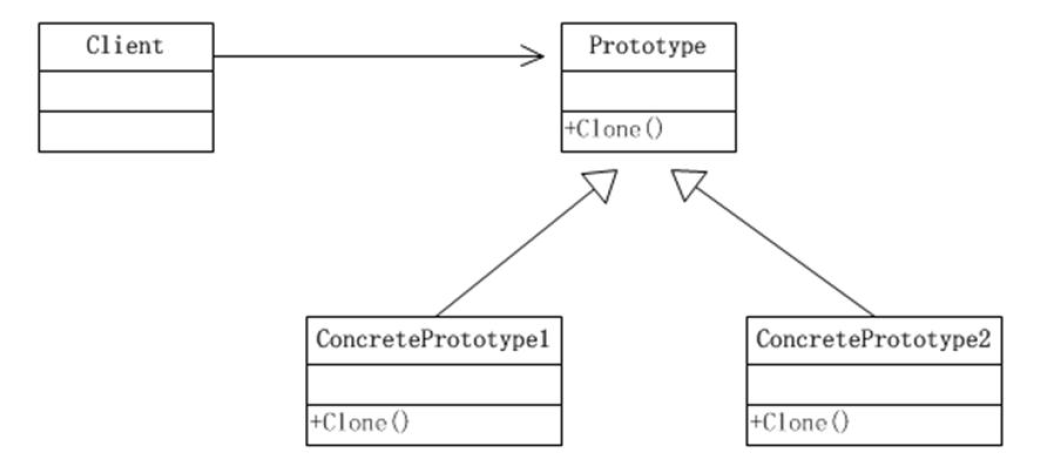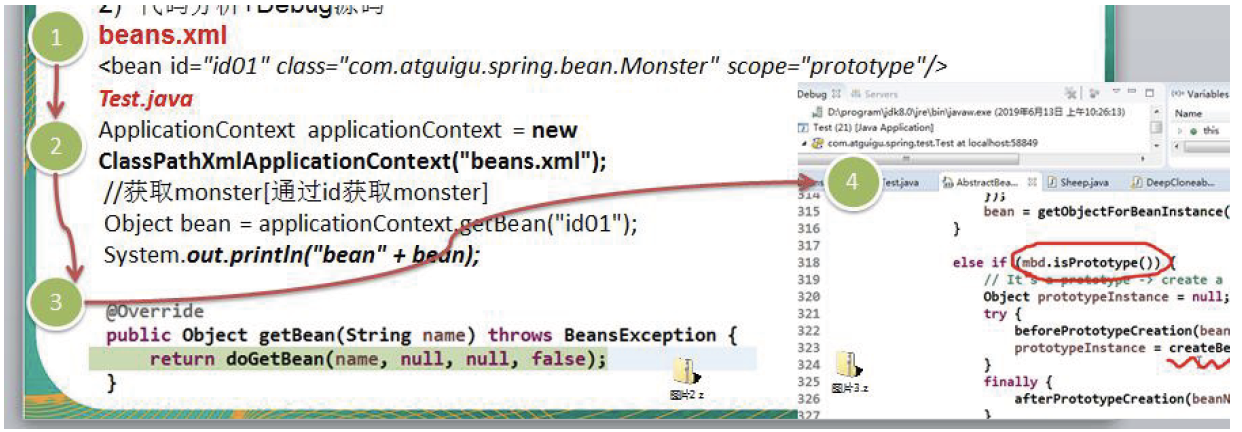1. 具体需求
克隆羊问题:
现在有一只羊tom,姓名为tom,年龄为1,颜色为白色,请编写程序创建和tom羊属性完全相同的10只羊。
2. 传统解决方式
1)思路分析

2)代码演示
1
2
3
4
5
6
7
8
9
10
11
12
13
14
15
16
17
18
19
20
21
22
23
24
25
26
27
28
29
30
31
32
33
34
|
public class Sheep {
private String name;
private int age;
private String color;
public Sheep(String name, int age, String color) {
super();
this.name = name;
this.age = age;
this.color = color;
}
public String getName() {
return name;
}
public void setName(String name) {
this.name = name;
}
public int getAge() {
return age;
}
public void setAge(int age) {
this.age = age;
}
public String getColor() {
return color;
}
public void setColor(String color) {
this.color = color;
}
@Override
public String toString() {
return "Sheep [name=" + name + ", age=" + age + ", color=" + color + "]";
}
}
|
1
2
3
4
5
6
7
8
9
10
11
12
13
14
15
16
17
18
19
20
21
22
|
public class Client {
public static void main(String[] args) {
Sheep sheep = new Sheep("tom", 1, "白色");
Sheep sheep2 = new Sheep(sheep.getName(), sheep.getAge(), sheep.getColor());
Sheep sheep3 = new Sheep(sheep.getName(), sheep.getAge(), sheep.getColor());
Sheep sheep4 = new Sheep(sheep.getName(), sheep.getAge(), sheep.getColor());
Sheep sheep5 = new Sheep(sheep.getName(), sheep.getAge(), sheep.getColor());
System.out.println(sheep);
System.out.println(sheep2);
System.out.println(sheep3);
System.out.println(sheep4);
System.out.println(sheep5);
}
}
|
3)传统方式的优缺点
- 优点是比较好理解,简单易操作
- 缺点是在创建新对象的时候,总是需要重新获取原始对象的属性,如果创建的对象比较复杂时,效率较低
- 总是需要重新初始化对象,而不是动态地获得对象运行时的状态,不够灵活
4)改进思路
Java中Object类是所有类的根类,Object类提供了一个clone()方法,该方法可以将一个Java对象复制一份,但是要实现clone的Java类必须要实现一个接口Cloneable,该接口表示该类能够复制且具有复制的能力->原型模式
3. 原型模式解决方式
3.1 基本介绍
1) 原型模式(Prototype 模式)是指:用原型实例指定创建对象的种类,并且通过拷贝这些原型,创建新的对象 2) 原型模式是一种创建型设计模式,允许一个对象再创建另外一个可定制的对象,无需知道如何创建的细节 3)工作原理是:通过将一个原型对象传给那个要发动创建的对象,这个要发动创建的对象通过请求原型对象拷贝它们自己来实施创建,即对象.clone() 4) 形象的理解:孙大圣拔出猴毛,变出其它孙大圣
3.2 原理图

原理图说明:
1)Prototype:原型类,声明一个克隆自己的接口
2)ConcretePrototype:具体的原型类,实现一个克隆自己的操作
3)Clint:客户端,让一个原型对象克隆自己,从而创建一个新的对象(属性一样)
3.3 应用实例
使用原型模式改进传统方式,让程序具有更高的效率和扩展性。
代码实现:
- 写原型类,实现Cloneable,重写clone方法
1
2
3
4
5
6
7
8
9
10
11
12
13
14
15
16
17
18
19
20
21
22
23
24
25
26
27
28
29
30
31
32
33
34
35
36
37
38
39
40
41
42
43
44
45
46
|
public class SheepPrototype implements Cloneable{
private String name;
private int age;
private String color;
public SheepPrototype(String name, int age, String color) {
super();
this.name = name;
this.age = age;
this.color = color;
}
public String getName() {
return name;
}
public void setName(String name) {
this.name = name;
}
public int getAge() {
return age;
}
public void setAge(int age) {
this.age = age;
}
public String getColor() {
return color;
}
public void setColor(String color) {
this.color = color;
}
@Override
public String toString() {
return "Sheep [name=" + name + ", age=" + age + ", color=" + color + "]";
}
@Override
protected Object clone() {
SheepPrototype sheepPrototype = null;
try {
sheepPrototype = (SheepPrototype)super.clone();
}catch (Exception e){
System.out.println(e.getMessage());
}
return sheepPrototype;
}
}
|
- 使用
1
2
3
4
5
6
7
8
9
10
11
12
| public class Client {
public static void main(String[] args) {
SheepPrototype sheep = new SheepPrototype("tom", 1, "white");
SheepPrototype sheep2 = (SheepPrototype) sheep.clone();
SheepPrototype sheep3 = (SheepPrototype) sheep.clone();
SheepPrototype sheep4 = (SheepPrototype) sheep.clone();
SheepPrototype sheep5 = (SheepPrototype) sheep.clone();
System.out.println(sheep2.toString());
System.out.println(sheep3.toString());
}
}
|
使用的是克隆,两个对象只是属性相同,并不==
4. 原型模式在Spring框架中源码分析
1)Spring中原型bean的创建,就是原型模式的应用
2)代码分析+Debug源码
 image-20221125164741778
image-20221125164741778
5. 深入讨论-深拷贝和浅拷贝
5.1 浅拷贝基本介绍
1)对于数据类型是基本数据类型的成员变量,浅拷贝会直接进行值传递,也就是将该属性值复制一份给新的对象。 2) 对于数据类型是引用数据类型的成员变量,比如说成员变量是某个数组、某个类的对象等,那么浅拷贝会进行引用传递,也就是只是将该成员变量的引用值(内存地址)复制一份给新的对象。因为实际上两个对象的该成员变量都指向同一个实例。在这种情况下,在一个对象中修改该成员变量会影响到另一个对象的该成员变量值。(对象的属性没有真正的复制,而是指向同一个空间)
3)前面我们克隆羊就是浅拷贝
4)浅拷贝是使用默认的clone() 方法来实现
sheepPrototype = (SheepPrototype)super.clone();
5.2 深拷贝基本介绍
1)复制对象的所有基本数据类型的成员变量值 2)为所有引用数据类型的成员变量申请存储空间,并复制每个引用数据类型成员变量所引用的对象,直到该对象可达的所有对象。也就是说,对象进行深拷贝要对整个对象(包括对象的引用类型)进行拷贝
- 深拷贝实现方式 1:重写 clone 方法来实现深拷贝
- 深拷贝实现方式2:通过对象序列化实现深拷贝(推荐) ### 5.3 深拷贝应用实例 1)使用重写clone方法实现深拷贝 2)使用序列化来实现深拷贝
- 代码演示
1
2
3
4
5
6
7
8
9
10
11
12
13
14
15
16
17
18
19
20
|
public class DeepCloneableTarget implements Serializable, Cloneable {
private static final long serialVersionUID = 1L;
private String cloneName;
private String cloneClass;
public DeepCloneableTarget(String cloneName, String cloneClass) {
this.cloneName = cloneName;
this.cloneClass = cloneClass;
}
@Override
protected Object clone() throws CloneNotSupportedException {
return super.clone();
}
}
|
1
2
3
4
5
6
7
8
9
10
11
12
13
14
15
16
17
18
19
20
21
22
23
24
25
26
27
28
29
30
31
32
33
34
35
36
37
38
39
40
41
42
43
44
45
46
47
48
49
50
51
52
53
54
55
56
57
58
59
60
61
|
public class DeepProtoType implements Serializable, Cloneable {
public String name;
public DeepCloneableTarget deepCloneableTarget;
public DeepProtoType() {
super();
}
@Override
protected Object clone() throws CloneNotSupportedException {
Object deep = null;
deep = super.clone();
DeepProtoType deepProtoType = (DeepProtoType)deep;
deepProtoType.deepCloneableTarget = (DeepCloneableTarget)deepCloneableTarget.clone();
return deepProtoType;
}
public Object deepClone() {
ByteArrayOutputStream bos = null;
ObjectOutputStream oos = null;
ByteArrayInputStream bis = null;
ObjectInputStream ois = null;
try {
bos = new ByteArrayOutputStream();
oos = new ObjectOutputStream(bos);
oos.writeObject(this);
bis = new ByteArrayInputStream(bos.toByteArray());
ois = new ObjectInputStream(bis);
DeepProtoType copyObj = (DeepProtoType)ois.readObject();
return copyObj;
} catch (Exception e) {
e.printStackTrace();
return null;
} finally {
try {
bos.close();
oos.close();
bis.close();
ois.close();
} catch (Exception e2) {
System.out.println(e2.getMessage());
}
}
}
}
|
1
2
3
4
5
6
7
8
9
10
11
12
13
14
15
16
17
18
19
20
21
22
23
24
25
|
public class DeepClient {
public static void main(String[] args) {
DeepProtoType deepProtoType = new DeepProtoType();
deepProtoType.name = "A";
deepProtoType.deepCloneableTarget = new DeepCloneableTarget("Target","ooo");
try {
DeepProtoType clone = (DeepProtoType) deepProtoType.clone();
System.out.println("-----方式1-----");
System.out.println("name=" + deepProtoType.name + " deepCloneTarget hashcode = " + deepProtoType.deepCloneableTarget.hashCode());
System.out.println("----After Deep Clone---");
System.out.println("name=" + clone.name + " deepCloneTarget hashcode = " + clone.deepCloneableTarget.hashCode());
DeepProtoType clone2 = (DeepProtoType) deepProtoType.deepClone();
System.out.println("-----方式2-----");
System.out.println("name=" + deepProtoType.name + " deepCloneTarget hashcode = " + deepProtoType.deepCloneableTarget.hashCode());
System.out.println("----After Deep Clone---");
System.out.println("name=" + clone2.name + " deepCloneTarget hashcode = " + clone2.deepCloneableTarget.hashCode());
} catch (CloneNotSupportedException e) {
e.printStackTrace();
}
}
}
|
6. 原型模式注意事项和细节
1)创建新的对象比较复杂时,可以利用原型模式简化对象的创建过程,同时也能够提高效率。 2) 不用重新初始化对象,而是动态地获得对象运行时的状态。 3) 如果原始对象发生变化(增加或者减少属性),其它克隆对象的也会发生相应的变化,无需修改代码。 4) 在实现深克隆的时候可能需要比较复杂的代码 缺点:需要为每一个类配备一个克隆方法,这对全新的类來说不是很难,但对已有的类进行改造时,需要修改其源代码,违背了ocp 原则。


